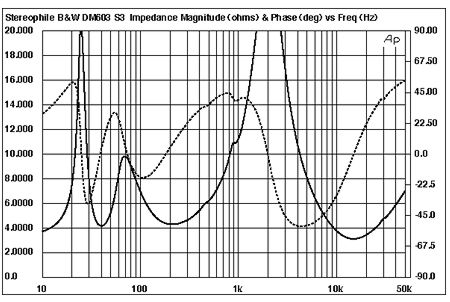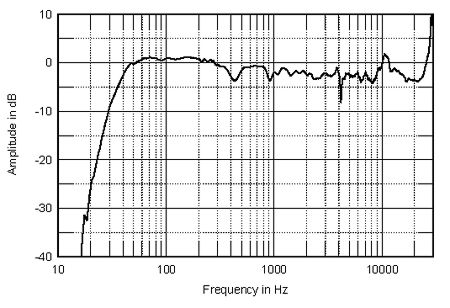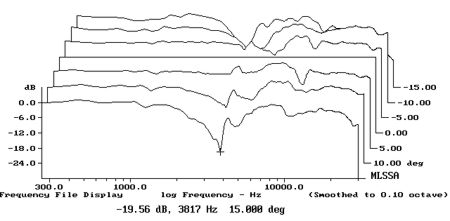| Columns Retired Columns & Blogs |
B&W DM603 S3 loudspeaker Measurements
Sidebar 3: Measurements
The handsome B&W DM603 S3 has higher-than-average voltage sensitivity, at an estimated 89dB(B)/2.83V/m. Though this is slightly lower than the specified 90dB, the difference is not that significant, given the usual experimental error. The speaker's impedance plot (fig.1), however, indicates that it is a moderately difficult load, at least at very high frequencies, where the magnitude drops to 3.1 ohms at 15kHz. Fortunately, music has very little energy in this region, and at low frequencies the speaker remains above 4 ohms.

Fig.1 B&W DM603 S3, electrical impedance (solid) and phase (dashed). (2 ohms/vertical div.)
There is a very slight discontinuity in the impedance traces at 440Hz, and I did find a moderately high resonant mode in the cabinet sidewalls at this frequency. This frequency is also high enough that it might not degrade sound quality. However, I did find a high-level vibrational mode on the rear panel (fig.2), at 160Hz, a frequency where some lower-midrange congestion might be the result. Though this panel faces away from the listener, minimizing the possible audibility of the mode, I would have preferred not to have found it at all. I did wonder if it was associated with the touch of color BJR noted on Joni Mitchell's voice.

Fig.2 B&W DM603 S3, cumulative spectral-decay plot calculated from the output of an accelerometer fastened to the center of the cabinet's rear panel (MLS driving voltage to speaker, 7.55V; measurement bandwidth, 2kHz).
With its twin ports, a woofer, and a midrange unit, the DM603's low-frequency behavior is complex. On the left-hand side of fig.3 are shown the nearfield responses of the midrange unit (black trace), the woofer (red), the upper, rear-facing port (blue), and the lower port on the front baffle (green). All four radiators operate in the bass, with both the woofer and the midrange unit showing the expected notch at their port tuning frequencies. The midrange unit is tuned fractionally higher in frequency than the woofer—41Hz re: 38Hz—with the latter acting less as a full-range unit than as a fill-in driver to flesh out the speaker's upper-bass output.

Fig.3 B&W DM603 S3, acoustic crossover on tweeter axis at 50", corrected for microphone response, with the nearfield responses of the midrange unit (black), woofer (red), upper port (blue), and lower port (green).
Higher in frequency, the midrange unit crosses over to the tweeter just below 4kHz, as specified, though its low-pass rollout is marred by a very narrow suckout at 4080Hz. The tweeter's ultrasonic dome resonance lies close to 30kHz, well away from the audioband. Below 300Hz, fig.4 shows how these individual responses sum in the farfield, weighted according to their radiating diameters and taking into account acoustic phase and the relative distance of each radiator from the nominal farfield microphone position. Above 300Hz, this graph shows the true farfield response, averaged across a 30° horizontal window centered on the tweeter axis. Both the bass region and the upper midrange and treble are impressively flat, though the former is shelved up by 3dB or so. Below 150Hz this will be partly due to the nearfield measurement technique; as BJR found in his auditioning, however, this B&W speaker offers excellent bass extension.

Fig.4 B&W DM603 S3, anechoic response on tweeter axis at 50", averaged across 30° horizontal window and corrected for microphone response, with the complex sum of the nearfield midrange, woofer, and port responses, taking into account acoustic phase and distance from the nominal farfield point, plotted below 300Hz.
The B&W DM603 offers superbly well-controlled horizontal dispersion, as revealed by fig.5. Even with its high crossover frequency to the tweeter, there is very little sign of the usual flare at the bottom of the tweeter passband except at extreme off-axis angles, and the contour lines are impressively evenly spaced, something that correlates both with a neutral perceived in-room balance and stable stereo imaging. In the vertical plane (fig.6), the B&W's balance doesn't change significantly as long as the listener's ears remain within ±5° of the tweeter axis. Much above or below that region and a suckout develops in the upper crossover region that will make the speaker sound a little hollow.

Fig.5 B&W DM603 S3, lateral response family at 50", normalized to response on tweeter axis, from back to front: differences in response 90–5° off axis, reference response, differences in response 5–90° off axis.

Fig.6 B&W DM603 S3, vertical response family at 50", normalized to response on tweeter axis, from back to front: differences in response 15–5° above axis, reference response, differences in response 5–15° below axis.
In the time domain, the DM603 S3's step response on the tweeter axis (fig.7) indicates that all three drive-units are connected with positive acoustic polarity, with the tweeter's output slightly leading that of the midrange unit and woofer. However, the return to the time axis of the tweeter's overshoot coincides exactly with the positive-going rise away from the time axis of the midrange/woofer step, correlating with the excellent frequency-domain integration seen between the units in fig.4.

Fig.7 B&W DM603 S3, step response on tweeter axis at 50" (5ms time window, 30kHz bandwidth).
Finally, the DM603's cumulative spectral-decay or waterfall plot (fig.8) is overall very clean, but reveals that the sharp on-axis notch in the woofer's output is associated with a ridge of delayed energy at the same frequency. I might have expected a slight degree of hardness to result from this behavior, but I note that BJR didn't comment on any mid-treble problems.

Fig.8 B&W DM603 S3, cumulative spectral-decay plot at 50" (0.15ms risetime).
As is to be expected from the company's investment in research—an investment I witnessed firsthand last fall when I paid a visit to B&W's factory in Worthing and its R&D lab in Steyning, both in that most English of English counties, West Sussex—the DM603 S3 demonstrates impressive speaker engineering at a very affordable price, even with its rather lively cabinet. I am not surprised that BJR (and his wife) liked this speaker as much as they did.—John Atkinson
- Log in or register to post comments




































